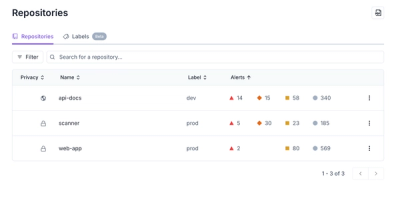
Product
Redesigned Repositories Page: A Faster Way to Prioritize Security Risk
Our redesigned Repositories page adds alert severity, filtering, and tabs for faster triage and clearer insights across all your projects.
github.com/ashellunts/ffmpeg-to-webrtc
ffmpeg-to-webrtc demonstrates how to send video from ffmpeg to your browser using pion.
In the jsfiddle the top textarea is your browser's SDP, copy that to clipboard.
cd srcsrc/SDP.txt.go run . <ffmpeg command line options> - < SDP.txt-pix_fmt yuv420p -c:v libx264 -bsf:v h264_mp4toannexb -b:v 2M -max_delay 0 -bf 0 -f h264.When you see SDP in base64 format printed it means that SDP is already in clipboard. So you can go to jsfiddle page and paste that into Application SDP text area.
A video should start playing in your browser below the input boxes.
go run . -rtbufsize 100M -f dshow -i video="PUT_DEVICE_NAME" -pix_fmt yuv420p -c:v libx264 -bsf:v h264_mp4toannexb -b:v 2M -max_delay 0 -bf 0 -f h264 - < SDP.
There is a delay of several seconds. Should be possible to fix it with better ffmpeg configuration.
To check list of devices: ffmpeg -list_devices true -f dshow -i dummy.
It is possible also to set a resolution and a format, for example -pixel_format yuyv422 -s 640x480.
Possible formats: ffmpeg -list_options true -f dshow -i video=PUT_DEVICE_NAME.
See .bat files in src folder
Should work on other operating systems, though I haven't tried.
FAQs
Unknown package
Did you know?

Socket for GitHub automatically highlights issues in each pull request and monitors the health of all your open source dependencies. Discover the contents of your packages and block harmful activity before you install or update your dependencies.

Product
Our redesigned Repositories page adds alert severity, filtering, and tabs for faster triage and clearer insights across all your projects.

Security News
Multiple deserialization flaws in PyTorch Lightning could allow remote code execution when loading untrusted model files, affecting versions up to 2.4.0.

Security News
NVD now marks all pre-2018 CVEs as "Deferred," signaling it will no longer enrich older vulnerabilities, further eroding trust in its data.